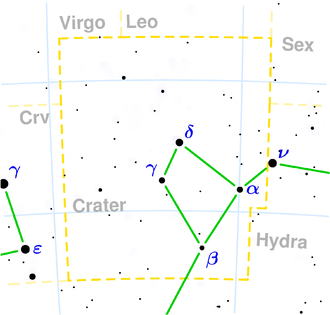Crater-II-Zwerggalaxie
| Galaxie Crater-II-Zwerggalaxie | |
|---|---|
| Crater 2 | |
| AladinLite | |
| Sternbild | Becher |
| Position Äquinoktium: J2000.0, Epoche: J2000.0 | |
| Rektaszension | 11h 49m 14,400s |
| Deklination | -18° 24′ 46,80″ |
| Erscheinungsbild | |
| Morphologischer Typ | dSph |
| Helligkeit (visuell) | (20,35 ± 0,02) mag |
| Winkelausdehnung | (62,4 ± 5,0)' |
| Physikalische Daten | |
| Zugehörigkeit | Lokale Gruppe |
| Entfernung | (383.000 ± 3.600) Lj / (117.500 ± 1.100) pc |
| Absolute Helligkeit | (−8,2 ± 0,01) mag |
| Durchmesser | 7000 Lj |
| Geschichte | |
| Entdeckung | VST ATLAS Survey |
| Entdeckungsdatum | 2016 |
| Katalogbezeichnungen | |
| Galaxie mit sehr geringer Helligkeit | |
Die Crater-II-Zwerggalaxie, kurz auch Crater II oder Crater 2, ist eine im Jahr 2016 entdeckte Zwerggalaxie des Typs dSph im Sternbild Becher in der Lokalen Gruppe und eine der Satellitengalaxien der Milchstraße.
Eigenschaften
Sie wurde vom VST ATLAS Survey der Europäischen Südsternwarte in Chile entdeckt. Sie weist eine sphäroide Form auf und befindet sich etwa 390.000 Lichtjahre vom Sonnensystem entfernt. Die Galaxie hat einen Halblichtradius von circa 1100 Parsec und hat einen Durchmesser von 7000 Lichtjahren, was sie zur viertgrößten Satellitengalaxie der Milchstraße macht. Crater 2 ist eines der am schwächsten leuchtenden Himmelsobjekte, welches jemals entdeckt wurde.
Der Astronom Gabriel Torrealba von der University of Cambridge und dessen Kollegen sind der Auffassung, dass sich Crater 2 möglicherweise wie die Leo-II-, Leo-IV- und Leo-V-Zwerggalaxien zuvor aus demselben Sternhaufen gebildet haben könnte.[1]
Weiteres
- Liste der Galaxien der Lokalen Gruppe
Weblinks
- dailymail - The 'feeble giant' lurking near the Milky Way: Previously unknown Crater 2 star cluster is spotted orbiting our galaxy (englisch, 15. April 2016)
- New Scientist - Never-before-seen galaxy spotted orbiting the Milky Way (englisch, 14. April 2016)
Einzelnachweise
Auf dieser Seite verwendete Medien
Caption from NASA: Like early explorers mapping the continents of our globe, astronomers are busy charting the spiral structure of our galaxy, the Milky Way. Using infrared images from NASA's Spitzer Space Telescope, scientists have discovered that the Milky Way's elegant spiral structure is dominated by just two arms wrapping off the ends of a central bar of stars. Previously, our galaxy was thought to possess four major arms.
This artist's concept illustrates the new view of the Milky Way, along with other findings presented at the 212th American Astronomical Society meeting in St. Louis, Mo. The galaxy's two major arms (Scutum-Centaurus and Perseus) can be seen attached to the ends of a thick central bar, while the two now-demoted minor arms (Norma and Sagittarius) are less distinct and located between the major arms. The major arms consist of the highest densities of both young and old stars; the minor arms are primarily filled with gas and pockets of star-forming activity.
The artist's concept also includes a new spiral arm, called the "Far-3 kiloparsec arm," discovered via a radio-telescope survey of gas in the Milky Way. This arm is shorter than the two major arms and lies along the bar of the galaxy.
Our sun lies near a small, partial arm called the Orion Arm, or Orion Spur, located between the Sagittarius and Perseus arms.



